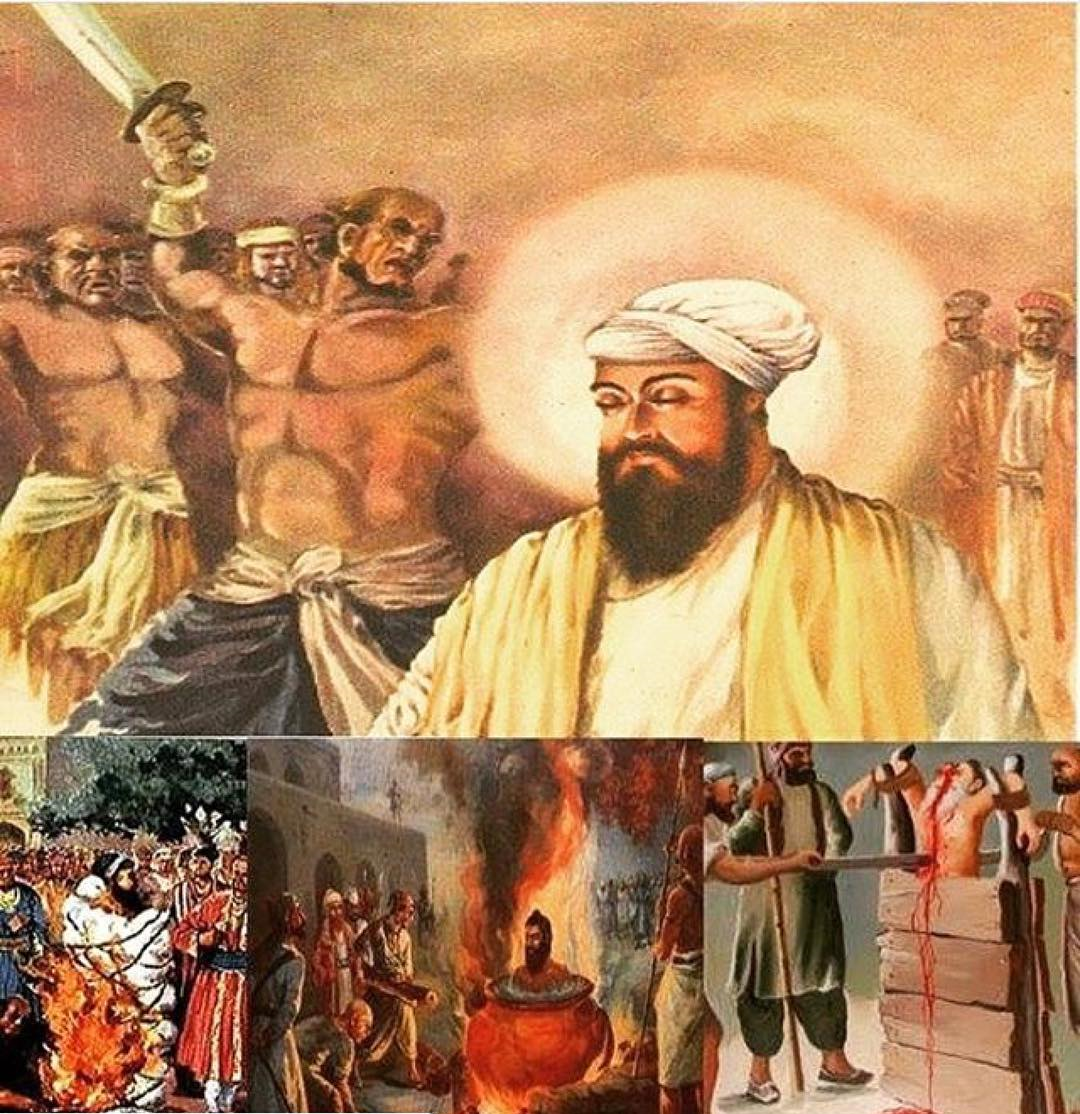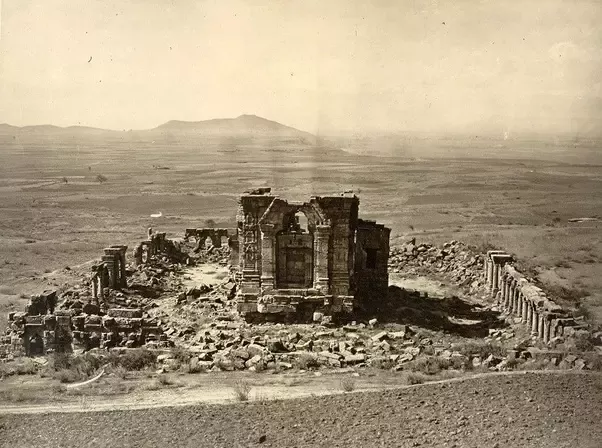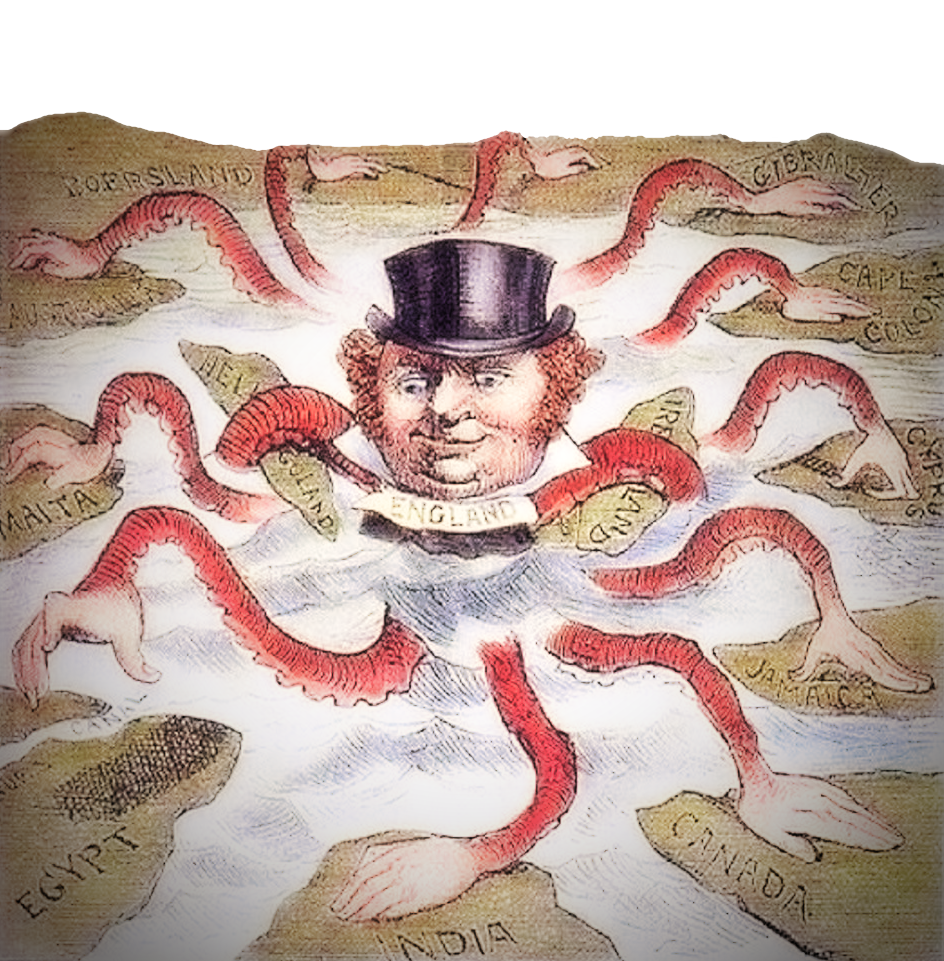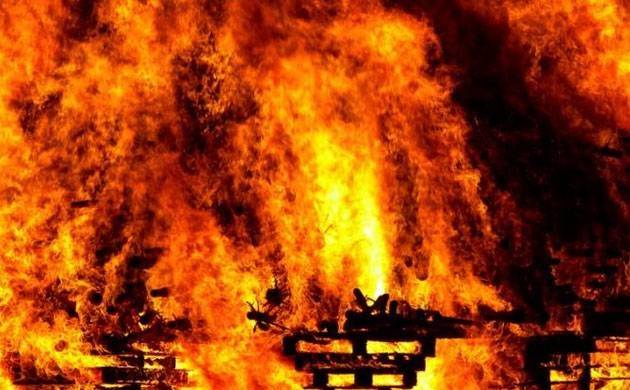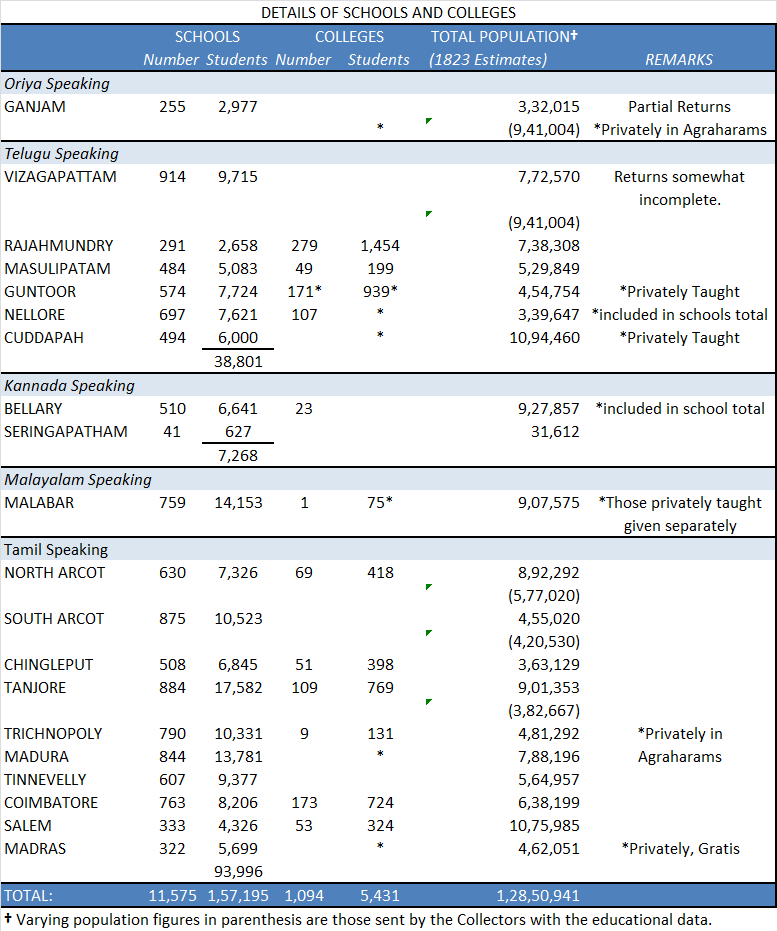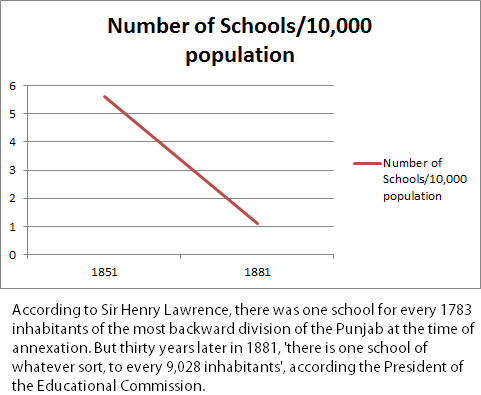A study of 2000 years of persecutions and inhuman cultural genocide against Hindus by various anti-human forces.
The Hindu Persecution
| Our Survival Needs |
Our Inspiration |
Our Life |
Our Identity |
Human Possibility |
| Trade Medicine Technology Knowledge Commerce Expertise Surgery Food |
Values Culture Tradition Architecture Bhakti Arts Scriptures |
Temples CelebrationGuru-disciple lineage Community Gurukuls |
Who am I? Civilization Glory |
Incarnations (Avatars) Enlightened Masters |
Our Survival Needs
Attacked by vested Interests
When the Mughals came, they saw the glitter of gold adorning our temples.
When the British came, they came as traders, but for the same gold.
When the consumerism attacked, it saw us their primary market.
When vested interests attack, they began the process of ethnic cleansing.
Atrocities
Whenever vested interests attacked Hinduism, it was always a war.
There were violent attacks, rape, deceit tactics, oppressive trade policies, illegal taxations, torture, beating, forceful conversion, and much more. Till date, it has been continuing though more subtle.
Francois Gautier in his book ‘Rewriting Indian History’ (1996) wrote:
“The massacres perpetuated by M_ in India are unparalleled in history, bigger than the Holocaust of the Jews by the Nazis; or the massacre of the Armenians by the Turks; more extensive even than the slaughter of the South American native populations by the invading Spanish and Portuguese.”
Sikandar Butshikan – Butcher of Kashmir
He was the sixth sultan of the Shah Miri dynasty of Kashmir. He ruled the kingdom from 1389 to 1413 and is remembered for his strenuous efforts to convert the Hindus of Kashmir to Islam. These efforts included the destruction of numerous old temples, prohibition of Hindu rites, rituals and festivals and even the wearing of clothes in the Hindu style. He is known as “Butcher of Kashmir” and among the most hated figures among Kashmiri Hindus.
Persecution of Hindus
Sultan Sikandar on the directions of the Sufi saint, Mir Mohammad Hamadani, he committed atrocities against non-Muslims in his lands. Large numbers of Hindus converted, fled, or were killed for refusal to convert during his reign.

A rare photo of ruins of Martand Sun Temple taken in 1868 by John Burke
Sikandar earned the sobriquet of but-shikan or idol-breaker, due to his actions related to the desecration and destruction of numerous temples, caityas, viharas, shrines, hermitages and other holy places of the Hindus and Buddhists. He banned dance, drama, music, and iconography as aesthetic activities of the Hindus and Buddhists, rejecting them as heretical and un-Islamic. He forbade the Hindus to apply a tilak mark on their foreheads. He did not permit them to pray and worship, blow a conch shell, or toll a bell. Eventually, he began burning temples and all Kashmiri texts to eliminate Shirk. Sikandar stopped Hindus and Buddhists from cremating their dead. Jizya (poll-tax) equal to 4 tolas of silver was imposed on the Hindus.
Records Baharistan-i-Shahi:
“ Immediately after his (Sufi Mir Mohammad’s) arrival, Sultan Sikandar, peace be on him, submitted to his supremacy and proved his loyalty to him by translating his words into deeds. He eradicated aberrant practices and infidelity. He also put an end to the various forbidden and unlawful practices throughout his kingdom. Thus during the entire period of his rule, all traces of wines and intoxicants and instruments of vice and corruption, like the cord of canticle, lyre, and tambourine were wiped out. The clamor of the drum and the trumpet, the shrill notes of the fife and the clarion no longer reached people’s ears, except in battles and assaults. ”
“Hindus were forcibly converted to Islam and were massacred in case they refused to be converted’,” writes Hasan, a Muslim chronicler. He further observes, “And Sikandarpora (a city laid out by Sultan Sikandar) was laid out on the debris of the destroyed temples of the Hindus. In the neighborhood of the royal palaces in Sikandarpora, the Sultan destroyed the temples of Maha-Shri built by Praversena and another by Tarapida. The material from these was used for constructing a ‘Jami’ mosque in the middle of the city.”
“Towards the end of his life, he (Sultan Sikandar) was infused with a zeal for demolishing idol-houses, destroying the temples and idols of the infidels. He destroyed the massive temple at Beejbehara. He had designs to destroy all the temples and put an end to the entire community of infidels,” puts Bharistan-i-Shahi.
Sadashiva’s Economics are “For Life”
“Sadashiva’s economics: Wherever things do not reduce by sharing – like education, it has to be given free. Education within the matrix is aparavidya. Education beyond the matrix is paravidya. Sadashiva is very clear. Even for apara-vidya you cannot charge.
The services that need to be done every day – the survival things, like food, medicine footwear etc he allows bartering. And only for the things that are longterm – such as construction – he allows currency transactions.
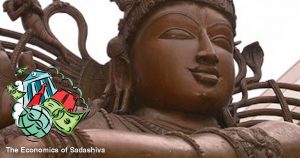 Sadashiva’s economic policies are where the society is most healthy. There are some places we cannot afford to have money as the decision maker. If you allow money to become decision maker in some places, humanity enters into the worst crisis. Like modern medicine. Like psychology.
Sadashiva’s economic policies are where the society is most healthy. There are some places we cannot afford to have money as the decision maker. If you allow money to become decision maker in some places, humanity enters into the worst crisis. Like modern medicine. Like psychology.
The whole society was built on this one principle of: “For Life”. The building structure was such that no few families can own the largest wealth or power or land. No single group can overpower. Billionaires who form a community where they only talk about billions, they become an altogether different species.
Identity-based on the currency has become so strong that they become altogether a different species. The structure of the society must be developed by such a visionary that these different species does not become the master of the Matrix. No one can imagine Sadashiva as an economist!
If Sadashiva allows money in the area of knowledge transmission, the number of years of education will be increased and the quality of the education will be drastically reduced. Because the more number of years you have them under your control, the more money you make.
When I study Sadashiva’s economics from the Agama, I can understand one thing: The whole spindle is on “oneness”. Even in your day to day life, he constantly reminds you about the oneness. Where you need to pay, where you don’t need to pay, where things are given to you free – even these things do not lead you to frustration.
The amount of frustration this generation is facing, one of the major reason is that they are realizing that they are being exploited. Exploited by prevalent things. Prevalent is different, existence is different. Planet Earth is existence. Ownership of prevalent. When prevalence takes over your innerspace and controls your decision making, understand you are an agent of the Matrix.
Till the British occupied us, we were the richest economy in the world. Stealing everything from us and making us believe that we are poor because of our tradition! Creating atrocity material – huge store of literature and making us believe that we are poor because we are Hindu! They have even coined the ugly word “Hindu Rate of Growth”.
You need to again and again and again drill the way you think, the way you cognize, the way you decide the goal of your life. Is it prevalence based items or existence based reality. Understand. Whatever is prevalent but not existence is artificial ignorance that has take over humanity. The concept of currency, the concept of ownership. I am not saying concept of currency should not be there or ownership should not be there. I am saying that should not be your goal of your purpose.
First point: Understand the matrix. When I studied Sadashiva’s economics, I saw he is very clear that people should not be caught in the matrix. He is very clear prevalent things are different and existential things are different. Even when you start questioning, you will understand that the prevalent is kept in its boundary. So it is not allowed to take over existence. So human beings are kept in every possible comfort, joy, love without being bought under the maya matrix.
Believing prevalence is reality is immaturity. Understanding prevalence and reality is maturity. Aligning yourself with reality is renunciation – Vairagya. Understanding the Maya Matrix.
Definition of courage is not absence of fear. Powerful-ness where fear cannot make you powerless is courage. Courage means not absence of information. Inability of information to make you powerless is courage. The ferociousness you need to use to break from the maya matrix. Once you break from the maya matrix, the same ferociousness you will use to break the rules of the maya matrix even within the maya matrix. That is what I call manifestation of powers.”
– His Divine Holiness Paramahamsa Nithyananda
The plunder during the Mughal and pre-British era
Foreign invaders attacked our temples and removed all the gold from the covering itself. Mahmud of Ghazni is said to have plundered, the Somnath Temple 17 times for gold. It was looted, destroyed, and resurrected several times. Home to one of the 12 Jyotirlings of India, the temple city of Somnath or Prabhas Patan is situated in the state of Gujarat on the Arabian Sea. It is said the temple was once completely covered with gold.
Naturally, the realization that this land was a golden bird, plunderers and invaders kept coming for thousands of years.
The British loot
In 1750, when Robert Clive came back with 900 large ships of gold coins, diamonds, pearls, silver etc. from India, there was a discussion in the London Parliament. Then British prime minister was stunned to hear about the amount of gold. More shocking was that it was just from a few ports and trade centers, such as Calcutta (Bengal), not the entire country. By controlling the ports, they controlled the import and export. Next, they took over all the trade. Clive was an extremely corrupt officer. He and his companions were the cause of a lot of cruel atrocities on innocent people. He was tried for his crimes and later committed suicide.
Recently one of Robert Clive’s wrecked ships was found under the ocean containing chests with gold coins.
This loot from 1700 didn’t end till the political independence of the county in 1947.
The graph below shows how India’s GDP fell during the British era.

The Illegal Freezing of Charitable Trust Bank Accounts
The first attack after the morphed video which the conspirators did on Paramahamsa Nithyananda was on the finances, the bank account. The bank accounts were completely illegally frozen by vested interests. As we see from the history. The first attacks always happened on weakening us economically.
https://nithyanandatruth.org/2017/12/18/illegal-freezing-of-trust-bank-accounts-by-vested-interests/
Destruction of The Education System by Macaulay
State of Indian Education, before Macaulay’s English Education act, 1835
Major Data Sources
- Official Survey of Indigenous Education in the Madras: 1822-26, which was order by the British Government and executed by the district collectors in accordance to the circular sent from the Board of Revenue.
- Extracts from W. Adam’s State of Education in Bengal: 1835-38
- Unofficial survey made by G.W. Leitner in Punjab: 1882
Overview of University Education a Millennium before Macaulay – Universities at Nalanda, Taxila and Vikramashila
Universities in Nalanda, Taxila and Vikramashila flourished under the patronage of the Hindu Gupta Empire in the 5th and 6th centuries and later under Harsha, the emperor of Kannauj. From the large numbers of texts that Yijing carried back with him after his 10-year residence at Nalanda, that there must have been a well-equipped library.
Libraries of Nalanda (Dharmaganja) – 3 Large multi-storeyed buildings
It is estimated that they housed a few hundreds of thousands of books:
- The Ratnodadhi (Sea of Jewels) : Nine storeys high and housed the most sacred manuscripts
- The Ratnasagar (Ocean of Jewels),
- The Ratnaranjaka (Jewel-adorned)
Destroyed
It was ransacked and destroyed by an army of the Mamluk Dynasty of the Delhi Sultanate under Bakhtiyar Khilji in c. 1200 CE. It is said when Bakhtiyar Khilji’s army invaded they burned the biggest Vedic library in the history of mankind.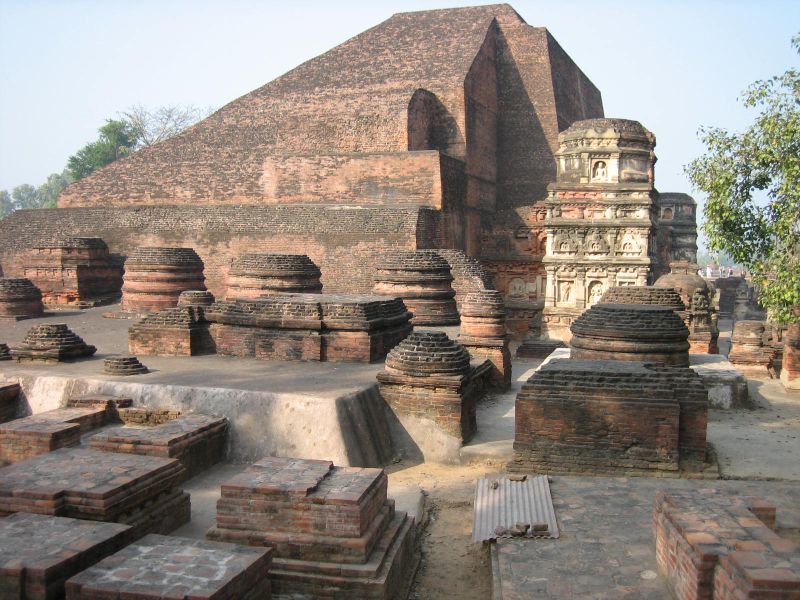
Burned Libraries
What was lost?
Religious manuscripts, Grammar, Logic, Literature, Astrology, Astronomy, and medicine. The Nalanda library had a classification scheme which was possibly based on a text classification scheme developed by the Sanskrit linguist, Panini. Buddhist texts were most likely divided into three classes based on the Tripitaka’s three main divisions: the Vinaya, Sutra, and the Abhidhamma.
What was destroyed included, extensive research and development was done in the fields of astronomy, mathematics, consciousness, arts, architecture, construction, civil engineering and medicine.
We don’t even know what we lost!
It can be easily understood by the following example. Aryabhata, one the pioneers in the field of mathematics and astronomy from that era. Aryabhata’s value for the length of the sidereal year at 365 days 6 hours 12 minutes 30 seconds is only 3 minutes 20 seconds longer than the modern scientific value of 365 days 6 hours 9 minutes 10 seconds. Which is like an error margin of 0.000633762% .
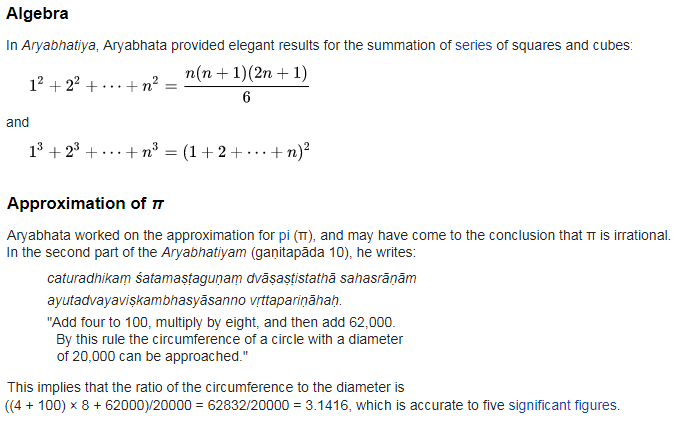
Kerala school of astronomy and mathematics[i]
- The achievements of Kerala School of mathematics were documented by Englishman C. M. Whish in 1835. This is about nine years later to the date of the Survey of Indigenous Education in the Madras 1822-26.
- In attempting to solve astronomical problems, the Kerala school independently created a number of important mathematics concepts.
- Some noteworthy discoveries and contributions were made in the field of :
Infinite series, Calculus, differentiation and integration, Functions, Trigonometric functions, derivatives of trigonometric functions (later know as Taylor-Maclaurin) infinite series of sin(x), cos(x) and arctan(x), Leibniz method using quadrature, infinite series of arctan(x), infinite series expression for π (later known as Gregory series), rational approximation of the error for the finite sum of their series, special infinite series to obtain a more rapidly converging series for π.
[i] https://en.wikipedia.org/wiki/Kerala_school_of_astronomy_and_mathematics
Traces of Sanskrit terminologies
| Sanskrit | English |
|---|---|
| Patha | Path |
| Aksh | Axis |
| Dvaar | Door |
| Naam | Name |
| Madhyam | Medium |
| Gyamitiya | Geometry |
| Trikonmiti | Trigonometry |
| Anamika | Anonymous |
Until a few thousand years ago, and in some cases just up until a few hundred years ago, India was the only civilization which had already made important discoveries in mathematics, trigonometry, calculus, medicine, metallurgy etc. Hence all those terminologies were already part of Sanskrit.
As Arabic & European civilizations adopted and study these sciences, the words evolved into their modern forms but it is well known that the knowledge has root in India.
The number of words in other languages which seem to have been originzated from Sanskrit is vast.[1][2]
References:
[1] https://en.wikipedia.org/wiki/List_of_English_words_of_Sanskrit_origin
[2] http://www.hitxp.com/articles/culture/sanskrit-greek-english-latin-roman-words-derived-pie-proto-indo-european-language/
Overview of the primary school education system right before Macaulay
- The Indian Education system, which was at least a few thousand years old, older than most Abrahamic religions, was completely wiped out in a century during the British Rule.
- Based on the reports, the Governor, Sir Thomas Munro, was of the view that institutional education of the boys between the ages of 5 to 10 years appeared to be a little more than 1/4th, nearer to 1/3rd of the boys of that age in the Presidency as a whole[i]. Madras Presidency represented literally 1/3rd of India.
- The survey carried out in Madras Presidency was done a specific prescribed format. The numbers of schools, colleges were to be mentioned. The student population had to be described as per gender (Male, Female, Transgender) and as Brahmin, Vaishya, Shudra and Other castes.
- Sir Thomas Munro, the Governor, observed that the Indian education would certainly have been far ahead during its glorious peak[ii], during the times the times of Takshila and Nalanda University. But right then, during 1830s, Indian education system was already damaged and suffering due to series of invasion and increasing poverty of the population.
- As per W. Adam’s report, there was at least one school in every village. He observed that there exist about 1,00,000 village schools in Bengal and Bihar around the 1830s.[iii]
[i][ii] Thomas Munro in his review of 10 March 1826. The Beautiful Tree, Dr. Dharampal, Page 26.
[iii] Report on the state of Education in Bengal, 1835. p.6.
How the Indian Education compared with the state of education in Europe and particularly England
- The content of studies was better than what was then studied in England.
- The economy at which education was imparted impressed British collectors that they suggested it be replicated in Britain [i], which indeed did inspire the British education later on.
- The duration of study was more prolonged. The collectors (apart from Nellore and Salem) stated that the duration of study varied from a minimum of 5 to about a maximum of 15 years [ii]. Average schooling year in Britain was 1 year in 1835, and 2 years in 1852.
For Indian traditional schools typical age of enrolment was 5 years. The duration of schooling hours was also much longer. It started at 6 AM, had one or two short intervals for meals, finishing about at sunset [iii]. - The method of school teaching was superior and it is this very method which is said to have greatly helped the introduction of popular education in England but which had prevailed in India for centuries.
- School attendance, especially in the districts of the Madras Presidency, even in the decayed state of the period 1822-25, was proportionately far higher than the numbers in all variety of schools in England in 1800[iv].
- The conditions under which teaching took place in the Indian schools were less dingy and more natural; and, it was observed, the teachers in the Indian schools were generally more dedicated and sober than in the English versions. Education was imparted without violence[v].
[i] The economy with which children are taught to write in the native schools, and the system by which the more advanced scholars are caused to teach the less advanced and at the same time to confirm their own knowledge is certainly admirable, and well deserved the imitation it has received in England. – A.D. Campbell, Collector, Bellary, 17th August 1823.
[ii][iii][iv] The Beautiful Tree, Dr. Dharampal, Page 30, 31, 20
FRA PAOLINO DA BARTOLOMEO, ON EDUCATION OF CHILDREN IN INDIA, (Born at Hos, Austria, 1748, as John Phillip Wesdin; in India 1776 to 1789. From Voyages to the East Indies (Published, Rome, 1796, Berlin, 1798, England, 1880), Book II: Birth and Education of Children (pp.253-268))
[v] MALABAR BIBLIOGRAPHY, THEIR PROGRESS IN LITERATURE, EDUCATION—SYSTEM BORROWED FROM IT. ACCOUNT OF IT FROM PETER DELLA VALLE. CUSTOM IN MALABAR TO TRANSLATE WORKS FROM SANSCRIT, MANNER OF WRITING OR ENGRAVING ON LEAVES. QUOTATION FROM LUSIAD. LIST OF BOOKS. (National Library of Scotland Edinburgh: Walker of Bowland Papers 184 a 3, Chapter 31: pp.501-27)
A few unique aspects of the primary education (As identified by British)
- Monitorial System[i][ii] – For initial mode of learning and not for higher education a novel method of education existed where the pupils were monitors of each other. Example – The tutor would choose some 3-4 monitors and impart them a particular lesson. For instance – the multiplication table. The monitors would sit crossed legged on a sandy ground, and recite the multiplication table (sometimes like a song), “one by itself makes one.” Along with reciting, the monitor would also write the same on the sand with his finger. After this other students repeated the same task. The ground by now had to be planned for the next lesson. The monitors would then start with the multiplication table of two and so on. The process was unique as it involved the following
- Low cost to benefit ratio. No use paper and pen.
- Redundancy: There were 3-4 monitors and thus if even if one of them made a mistake, he was likely to be corrected by the other three. All four were unlikely to make the exact same mistake.
- Scalability: The system allowed a single teacher to handle a large number of students.
- The stolen idea: The system was adopted by the British, repackaged as Bell’s “Madras System” with the idea to produce a “Christian Education” and “train children in the practice of such moral habits as are conducive to the welfare of society.” The system was introduced in several countries. With time however it was replaced with other systems particularly – the lecture model of direct instruction delivered to passive students grouped into classes by age.
- Teaching not confined to classroom and linked to nature.
- Close relationship between student and teacher
- Memorization: The children were known to memorize multiplication tables as far as 100[iii]. In current era, it is often limited to 16.
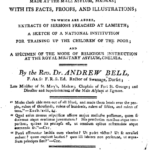 [i] Peter Della Valle published an account of this mode of instruction in Malabar 22nd November 1623, mentioned in Walker of Bowland Papers 184 a 3, Chapter 31: pp.501-27)
[i] Peter Della Valle published an account of this mode of instruction in Malabar 22nd November 1623, mentioned in Walker of Bowland Papers 184 a 3, Chapter 31: pp.501-27)
[ii]https://en.wikipedia.org/wiki/Monitorial_System#The_Madras_System
[iii] The Beautiful Tree, Dr. Dharampal, Page 53
Imparted Education to commons
- The term Scheduled caste and Scheduled Tribes did not exists during that era, but were mentioned as ‘other castes’ (also known as ‘pachamas’) in the report[i].
- 70% of the students (70% in Salem and Tinnevelly to over 84% in South Arcot) were from ‘Shudra’ community[i]. and ‘other castes’. This was the trend for most of country. The lowest was observed in Telgu speaking districts 35%.
- Around 20% of the students were of of ‘Brahmin’ and the ‘Vaishya’ community[i].
- In some villages of Bihar, ‘Chandal’ and ‘Dom’ jati accounted for 50% of the students. In Bihar, nowhere did the ‘Brahmin’ and ‘Kayastha’ jati accounted for more than 40% of the total students [ii].
- All professions, traditions were respected. There was dignity of labour, farmer, priest, every part of the society. For example, a book on agriculture, used in that era, the second verse of the book, declares, “that if a learned priest who has knowledge of 4 vedas, even after learning 4 vedas if looks down at farming considering it inferiror, that person is surely to suffer from poverty”. The context of this verse is that all professions, including farming should be respected.
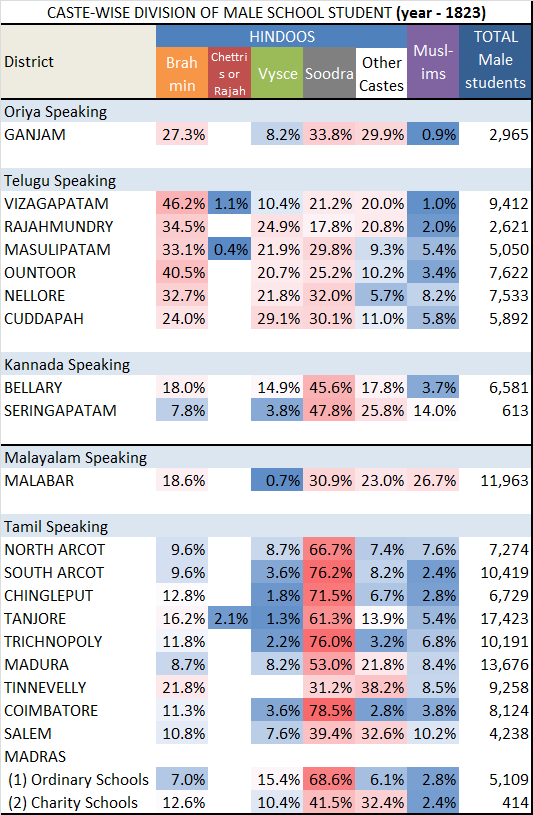
Superficial look at the numbers seems to suggest that the Brahmin community has the maximum population of the school going children. But if one looks at the Tamil Nadu region, he will see that it is actually the Sudra community (as labled by the British) which consists of the maximum school going children. If the average is taken of all regions put together, it is noticed the it is actually the Sudras which had the highest numbers of school going children. In such circumstances, the allegations made the Hindus deprived non-Brahmin community from education is untenable as per the official colonial era British records itself.
[i][ii] The Beautiful Tree, Dr. Dharampal, Page 88, Page 54
Institutions of Higher Learning – Colleges
- The term, ‘Institutions of Higher learning’ was used in the report to indicate colleges.
- The exact data on total number of colleges is not reliably available, as many collectors had not reported the required data, but based on the districts that were rigorously surveyed, for every 10 schools, there was one ‘Institute of Higher learning’.[i]
Rajahmundry – 279 colleges – for about 1000 villages, Coimbatore – 173 colleges, Guntoor – 171 colleges, Tanjore – 109 colleges, Nellore – 107 colleges, North Arcot – 69 colleges, Salem – 53 colleges, Chingleput – 51 colleges, Masulipatam – 49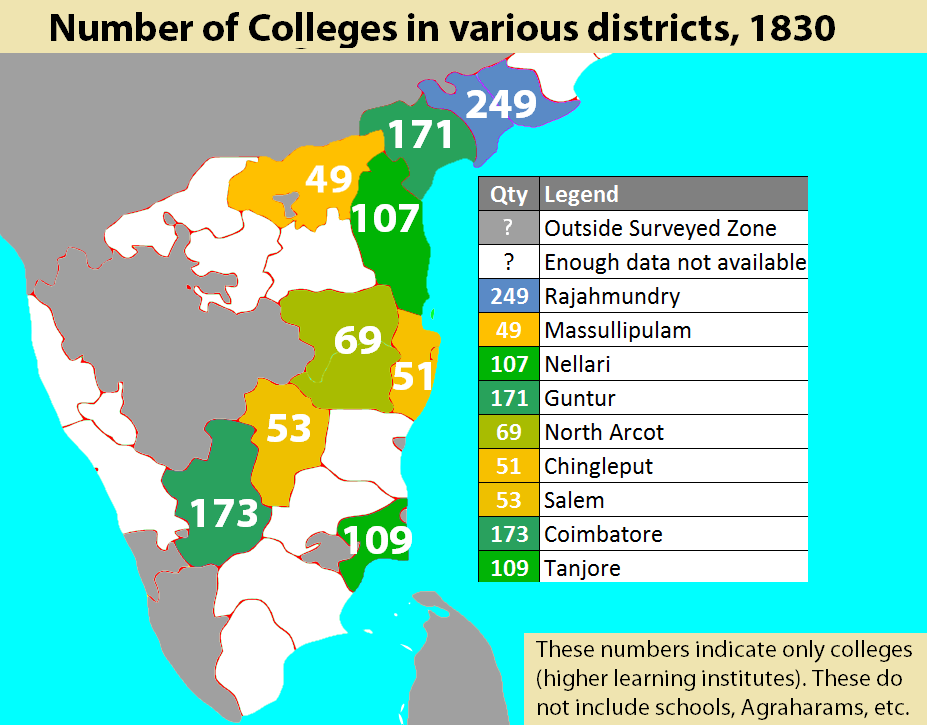
- The disciplines of Theology, Metaphysics, Ethics, and to a large extent of the study of Law was dominated by ‘Brahman’ community.[i]
- But the disciplines of Astronomy, Medical Science and technology based disciplines (such as Iron Work, Metallurgy, Ship building, Mechanics, Textile machinery) were dominated by other communities, notably ‘Shudra’ community.[i]
- It should also be noted that adherence of a jati to discipline was not rigid. A person of ‘Shudra’ jati, could very well be in a discipline dominated by the ‘Brahman’ jati and vice-versa.
[i] The Beautiful Tree, Dr. Dharampal, Page 35
Institutions of Higher Learning – Medicine & Surgery
- The data on exact number of colleges that were offering MS degree is not reliably available
- The educators and practitioners of surgery were often of the Shudra jati. Amongst them the Nayi jati was considered to the best by the British. In modern era however Nayis are considered to be marginal barbers[ii][iii].
- The education Ayurveda (Indian traditional medicine) was based on ancient texts such as Charaka Saṃhitā.
Sutra Sthana (General principles), Nidana Sthana (Pathology), Vimana Sthana (training of a physician, ethics, etc), Sarira Sthana (embryology & anatomy of a human body (with a section on other living beings)), Indriya Sthana (Sensory organ based prognosis), Cikitsa Sthana (Therapeutics), Kalpa Sthana (Pharmaceutics and toxicology), Siddhi Sthana (Success in treatment) - Other text books : Sham Raj, Nighant, Sharang Dhar, Bhashya Parichehed, Madhava Nidan, Vagbhat
- The education of surgery was based on ancient texts such as medico–surgical compendium Suśruta Saṃhitā (c. 500 BC), which were written by the ayurvedic physician Sushruta (c. 800 BC) who is considered the father of modern Surgery. It covers anatomy, treating fractures, general surgery, reconstructive plastic surgery, anaesthetics, rhinoplasty, perineal lithotomy, the suturing of wounds, and the extraction of foreign objects etc. The level of detail it covers goes into describing how foetus develops seven layers of skin, naming each layer and the specific diseases which may affect that layer in adult life, which is unimaginable for that era and made possible today only by microscopy, ultrasonography and X–rays.
- ‘Cutting of nose’ or “naak kata leyna” has traditionally been considered as a sign of shame in India. There have been numerous cases when a British officer, a high ranking officer, or his sub-ordinate, lost his nose partially or completely during war (with an Indian kingdom), as a sign of shame inflicted on him. Battles between Haider Ali and Colonel Coote being noteworthy examples[iv]. Sometimes the cut nose was completely burned to avoid being surgically fixed. Even such cases were treated by a complete reconstruction of nose along with nostrils. But it was only possible by an Indian surgeon (or Nayi). Interestingly such surgeons were available at the village level. In current era it is unimaginable to find a surgeon let alone a plastic surgeon in an Indian village. The Indian surgical practises were not only advanced they involved use of anaesthesia[v] which was unknown to the west as thus the operation was not barbarous and painful as in the west.
- The education and practise of surgery was not limited to male population. For example – W Adam, in his report, pp 119 – 122, for district Purneah, described an old woman surgeon who had become reputed for extracting the stone from the bladder.
- The practical value of this traditional system of education of medical science and surgery was presence of low price and yet reliable medical facilities even at the village level. W Adam for example in his report describes the Thana of Nattore in the district of Rajshahy – The population was 1,20,928; it had 485 villages had 123 native general medical practitioners, 205 village doctors, 21 smallpox inoculators, 297 women-midwives[vi]. In modern India, in 1973, the Kartar Singh Committee of the Government of India had recommended that there should be 1 midwife (Auxiliary nurse midwife – ANM) available per 10,000-12,000 people[vii].For Thana of Nattore as surveyed by W Adam, the ratio was amazingly 1 midwife per 408. This is 2456% more than what the government is recommending in the modern era. This shows that the availability of health care specialists was amazing. In modern era the child mortality rate in India is extraordinarily high, at 48 per 1000, for year 2015[viii].
- Smallpox inoculation (vaccination) is said to be the first vaccination developed, and Edward Jenner (in 1796) is credited to be the founding father. But much like how plastic surgery was copied from India, same is the case with smallpox inoculation, which was practiced in India since ancient times [ix][x][xi][xii][xiii][xiv]. However unlike surgery the credit has not been given to the Indian origin.
[ii] https://en.wikipedia.org/wiki/Nai_(caste)#cite_note-29 People of India Gujarat Volume XXI Part Three edited by R.B Lal, P.B.S.V Padmanabham, G Krishnan & M Azeez Mohideen pages 1415-1418
[iii] [vi] The Beautiful Tree, Dr. Dharampal, Page 35, Page 52
These surveys began to be made from 1812 onwards, and their main purpose was to find out what number of such medical men were in receipt of assignments of revenue. Some details of the castes of these practitioners may be found in Madras Board of Revenue Proceedings of 17 September 1821, and of 9 March 1837, and other proceedings referred to therein.
[iv] J. C. Carpue, ‘An Account of Two Successful Operations for Restoring a Lost Nose from the Integuments of the forehead…to which are prefixed Historical and Physiological Remarks on the Nasal Operation including Descriptions of the Indian and Italian Methods,’ London, 1816, pp.36-38 AND
SOME NARRATIONS ON INDIAN AGRICULTURE, PLASTIC SURGERY, TANK IRRIGATION SYSTEM, CHRONOLOGY AND ARCHITECTURE, INDIAN COTTON TEXTILE INDUSTRY AND OIL WELLS IN BURMA –Dharampal Collected Writings Volume II, pp.7-9 http://samanvaya.com/dharampal/frames/downloads/vol2.PDF
[v] Sushruta (1907). “Introduction”. In Kaviraj Kunja Lal Bhishagratna. Sushruta Samhita, Volume1: Sutrasthanam. Calcutta: Kaviraj Kunja Lal Bhishagratna. pp. iv.
[vii] https://en.wikipedia.org/wiki/Auxiliary_nurse_midwife
[viii] http://data.worldbank.org/indicator/SH.DYN.MORT
[ix] India Science and Technology in the eighteeth century – Dr. Dharampal, Page 2,Also see mid-eighteenth century Tracts on Inoculation in the British Museum
[x] Fenner F, Henderson DA, Arita I, Jezek Z, Ladnyi ID. Geneva: World Health Organization; 1988. Smallpox and its eradication; pp. 369–71
Dowdle WR. The principles of disease elimination and eradication. Bull World Health Organ. 1998;76(Suppl 2):22–5.
[xii] Fitchett JR, Heymann DL. Smallpox vaccination and opposition by anti-vaccination societies in 19 th century Britain. Hist Med. 1995;2:E17.
[xiii] Riedel S. Edward Jenner and the history of small pox and vaccination. BUMC Proc. 2005;18:21–5
[xiv] The College of Physicians of Philadelphia. The history of vaccines. Available from: http://www.historyofvaccines.org .
Destruction of Education system
Macaulay’s English Education act, 1835
To Zachary Macaulay, 12 October 1836
Our English schools are flourishing wonderfully. We find it difficult, indeed at some places impossible, to provide instruction for all who want it. At the single town of Hoogley fourteen hundred boys are learning English. The effect of this education on the Hindoos is prodigious. No Hindoo who has received an English education ever continues to be sincerely attached to his religion. Some continue to profess it as a matter of policy. But many profess themselves pure Deists, and some embrace Christianity……. It is my firm belief that, if our plans of education are followed up, there will not be a single idolater among the respectable classes in Bengal thirty years hence. And this will be effected without any efforts to proselytise, without the smallest interference with religious liberty, merely by the natural operation of knowledge and reflection. I heartily rejoice in this prospect….

No doubt, education decayed and illiteracy increased during the British period.
According to Sir Henry Lawrence, there was one school for every 1783 inhabitants of the most backward division of the Punjab at the time of annexation. But thirty years later in 1881, ‘there is one school of whatever sort, to every 9,028 inhabitants’, according the President of the Educational Commission.
William Adam estimated that there was 11% literacy in the Thana of Nattore during 1830s. A century later the British considered this an accomplishment in many parts of India.
Food, Agriculture
1770 Famine in Bengal
In 1750s, from Bengal Robert Clive may have got a thousand ships of gold. But soon after we saw a big famine.
The Bengal Famine of 1770 (Bengali: ৭৬-এর মন্বন্তর, Chhiattōrer monnōntór; lit The Famine of ’76) was a famine between 1769 and 1773 (1176 to 1180 in the Bengali calendar) that affected the lower Gangetic plain of India from Bihar to the Bengal region. The famine is estimated to have caused the deaths of up to 1 crore (10 million people). Warren Hastings’s 1772 report estimated that a third of the population in the affected region starved to death.
Bengal famine of 1943

As per Wikipedia : Bengal famine 1943-44
The Bengal famine of 1943-44 (Bengali: Pañcāśēra manwantara) was a major famine in the Bengal province[A][B] in British India during World War II. An estimated 2.1 million[C] people died from starvation and diseases aggravated by malnutrition, population displacement, unsanitary conditions, and lack of health care. Millions were impoverished as the crisis overwhelmed large segments of the economy and social fabric.
Bengal’s economy was predominantly agrarian. For at least a decade before the crisis, between half and three quarters of those dependent on agriculture were already at near subsistence level. The underlying causes of the famine include inefficient agricultural practices, over-population, and de-peasantisation through debt bondage and land grabbing. Proximate causes involve local natural disasters – a cyclone, storm surges and flooding, and rice crop disease – and various consequences arising from war. The government prioritised military and defense needs, allocating medical care and food disproporionately to the military and civil servants. These factors were compounded by restricted access to grain: domestic sources were constrained by emergency inter-provincial trade barriers, while access to international sources was largely denied by the War Cabinet of Great Britain. The relative impact of each of these contributing factors to the death toll and economic devastation is still a matter of controversy. Different analyses frame the famine against natural, economic, or political causes.
The government was slow to provide humanitarian aid, at first discouraging hoarding. It attempted to influence the price of rice paddy through price controls. These created a black market and encouraged sellers to withhold stocks; moreover, prices soared when the controls were abandoned. Relief efforts in the form of gruel kitchens, agricultural loans and test works were both insufficient and ineffective through the worst months of the food crisis phase. A long-established and detailed Famine Code would have triggered a sizable increase in aid, but the provincial government never formally declared a state of famine. Relief efforts increased significantly when the military took control of crisis relief in October 1943, and more effective aid arrived after a record rice harvest that December. Deaths from starvation began to decline, but “very substantially more than half” of the famine-related fatalities were caused by disease in 1944, after the food security crisis had subsided.[1]
Swami Vivekananda had said, “Ganga will have to be come red…to get people from Bengal to get out of the poverty consciousness and insensitivity wreaked on them because of the man-made famines”[Reference missing]
Hindu Food Security Model
Hinduism, is a civilization, rooted on the Shastras, an unbroken civilization since more than 10,000 years. Naturally it had already thought of solutions to problems such a famine and food security. The very reason why this problem happened in the first place was because of destruction of “Hindu Food Security Model”.
As already earlier mentioned, SadaShiva gave basic principles of Hindu economics clearly in Agamas
Wherever things do not reduce by sharing – like education, it has to be give free. Education within the matrix is aparavidya. Education beyond the matrix is paravidya. Sadashiva is very clear. Even for apara-vidya you cannot charge.The services that need to be done everyday – the survival things, like food, medicine footwear etc he allows bartering. And only for the things that are longterm – such as consutrction – he allows currency transaction
The destruction of the Gurukul Education system and Shashtras was the major reason for the collapse of food security which still continues even after independence of the country.
The food security model during that era was as follows
- A farmer would grow his crops.
- In case of a failure he will go to the temple.
- The temple cellars would have some donated grains collected by elderly men of the village.
- The elderly men would give the grains on loan to the farmer as much as he wanted on loan basis.
- Then the next year the farmer would return the same amount of grains + interest in form of grains to the temple.
- The interest charged would be only simple interest. There was a complete different set of agricultural accounting which was different from commercial accounting. The rules for bartering, charging interests, writing off grain loans etc, where completely different. The whole idea of compound interest was necessarily not there, because the whole point of the bank was not to exploit but to build food security for the village. “Krsi-Parasara” is one of the surviving agriculture accounting text of that era.
- This would slowly create a reserve of grains which would be useful in case of a famine. In case of famine the entire village would get the grains and all grain loans could be written off for the welfare of the large. Because there was no artificial currency associated with this write off, there was no corresponding hyper-inflation which hits the modern economy in many others ways in case of a major financial crisis.
- A neighboring village would even have the possibility to borrow(take loan) from another village in case of distress. The system was not highly institutionalized, and more like a dharmic seva started and handled by elderly people of the village, but it was this decentralized storage of grains with the context of – ‘Yes to Life’ from Agamas and Shashtras which protected the human civilization from agrarian crisis and famines for millenniums.
- The discontinuity of agriculture education, and education of agricultural accounting because of collapse of Gurukul System added further to the reason of discontinuity food banking system.
The destruction of the Gurukul Education system and Shashtras contributed to the collapse of food security and agrarian crisis, which still continues even after independence of the country. The collapse of decentralized food security system might have been revived, had that system been in place after the end of colonial eta.
In the following video we can see how the current commercial agriculture is not able to sustain the requirements of farmers and they are throwing their agriculture produce because sale price is lower than cost of production.
In the Gurukul education there was dignity of labour, farmer, priest & every part of the society. For example, a book on agriculture, used in that era, the second verse of the book, declares, “that if a learned priest who has knowledge of 4 vedas, even after learning 4 vedas if looks down at farming considering it inferior, that person is surely to suffer from poverty”. The context of this verse is that all professions, including farming should be respected.
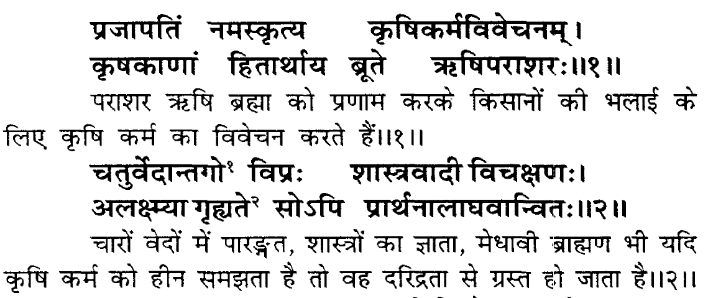
प्रजापतिं नमस्कृत्य कृषिकर्मविवेचन्।
कृषकाणां हितार्थाय ब्रूते ऋषिपराशरः॥१॥
पराशर ऋषि ब्रह्मा को प्रणाम करके किसानों की भलाई के लिए कृषि कर्म का विवेचन करते हैं||१||
चतुर्वेदान्तागो विप्रः शास्त्रवादी विचक्षणः|
अलाक्ष्म्या गृह्यतो सोऽपि प्रार्थनालाघवान्वितः॥२॥
चारों वेदों में पारङ्गत, शास्त्रों का ज्ञाता, मेधावी ब्राह्मण भी यदि कृषि कर्म को हीन समझता है तो वह् दरिद्रता से ग्रस्त हो जाता है॥२॥
No wonder the realized wages of Indian Hindu farmers and their productivity was much higher compared to European countries, as observed in Edinburgh Review, Vol 4, July 1804: Review of Dr. Tennant`s Indian Recreations, 2 vol, Extract pages 321-324.
A rich source of the state of Indian agriculture in the early British era is a report prepared by a British engineer, Thomas Barnard, and his Indian guide, Raja Chengalvaraya Mudaliar, around 1774. This report contains data of agricultural production in about 800 villages in the area around Chennai in the years 1762 to 1766. This report is available in Tamil in the form of palm leaf manuscripts at Thanjavur Tamil University, and in English in the Tamil Nadu State Archives. A series of articles in The Hindu newspaper in the early 1990s authored by researchers at The Centre for Policy Studies highlight the impressive production statistics of Indian farmers of that era.
A similar comparison of Bengal from William Adam’s report of agricultural production tonnage per hectare during 1800s is even more than today’s agricultural production tonnage per hectare with all available techniques. The hindu organic agriculture system surely had a profound positive impact on the food security of mankind.
SOME NARRATIONS ON INDIAN AGRICULTURE, PLASTIC SURGERY, TANK IRRIGATION SYSTEM, CHRONOLOGY AND ARCHITECTURE, INDIAN COTTON TEXTILE INDUSTRY AND OIL WELLS IN BURMA –Dharampal Collected Writings Volume II, pp.7-9 http://samanvaya.com/dharampal/frames/downloads/vol2.PDF
Knowledge
Commerce
Expertise
Surgery
